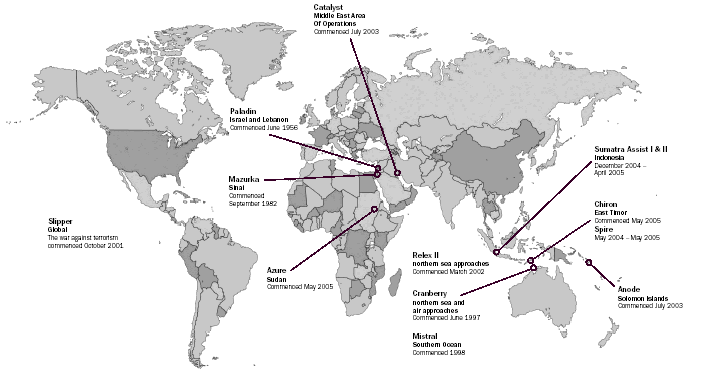OPERATIONS
During 2004-05 the ADF was involved in military operations, the provision of humanitarian support to other nations, and various joint and combined exercises involving the three Services and allied or regional military forces.
Operation Catalyst is the ADF’s contribution to the rehabilitation and reconstruction of Iraq. The ADF is part of a multinational force that is working to assist national recovery in order to develop a secure and stable environment.
Operation Slipper is the ADF’s contribution to the international coalition against terrorism and is an important component of the Australian Government's commitment to working with the international community to help prevent acts of terrorism around the world.
The ADF continued to lead the military component of the Regional Assistance Mission to Solomon Islands (RAMSI), a multinational regional force which provides support to the Australian Federal Police and the regional police forces (known as the Participating Police Force) in maintaining the rule of law and stability in the country.
The ADF continues to undertake operations against illegal fishing and unauthorised boat arrivals in Australia's northern approaches.
Currently, Australia has approximately 2,000 personnel deployed on operations with more than 1,300 of them deployed overseas. Map 4.1 shows areas of ADF involvement overseas and details of ADF involvement in major operations during 2004-05 are given in table 4.2.
4.1 AUSTRALIAN DEFENCE FORCE, Overseas operations - 2004-05

Source: Department of Defence.
4.2 AUSTRALIAN DEFENCE FORCE, Major operations(a) - 2004-05
|
MIDDLE EAST |
| Operation Catalyst | Operation Catalyst is Australia's contribution to the rehabilitation of Iraq. The ADF is participating in coalition efforts to develop a secure environment in Iraq, assist national recovery programs and facilitate the transition to Iraqi self-government. Operation Catalyst has comprised, on average, approximately 1,300 personnel. Forces have included:
- an Australian National Headquarters element
- a maritime element of one major naval vessel
- an aviation element including two C-130 Hercules aircraft, two P-3 Orion maritime patrol aircraft and an air traffic control detachment
- a security detachment to provide force protection and escort to the Australian mission in Iraq
- a contingent of ADF and civilian personnel working as embedded staff in various coalition headquarters
- a medical team of specialists providing intensive care at an Iraqi Military hospital
- the Al Muthanna Task Group compromising approximately 450 personnel and 40 light armoured vehicles. The task group is providing support to the Japanese-Iraq Reconstruction and Support Group and providing training to the Al Muthanna provincial Iraqi Security Forces
- two ADF training teams supporting training of the Iraqi Army and the Iraqi Coastal Defence Force.
|
| Operation Slipper | Operation Slipper is Australia's contribution to the war against terrorism and the multinational maritime interception force in the Persian Gulf. Deployed forces have included:
- an Australian National Headquarters element
- a maritime element of one frigate
- an aviation element of two P-3 Orion maritime patrol aircraft
- one Army officer working in a coalition headquarters in Afghanistan
- a Special Forces Task Group, comprising approximately 190 personnel.
|
|
EAST TIMOR |
| Operation Chiron | Operation Chiron is Australia's contribution to the United Nations (UN) Office in Timor-Leste and continues the work of Operation Spire, Australia's contribution to the UN Mission in support of East Timor which concluded in May 2005. Australia's contribution to Operation Chiron consists of four Military Advisers who provide a liaison and monitoring function in support of the Mission. |
|
AFRICA |
| Operation Azure | Operation Azure is the deployment of the ADF personnel to a UN peacekeeping operation in Sudan. The UN Security Council authorised the establishment of the UN Mission in Sudan on 24 March 2005 under resolution 1590. As at 1 August 2005, the military component numbered approximately nine personnel. |
|
SOLOMON ISLANDS |
| Operation Anode | Operation Anode is the ADF contribution to RAMSI. The military contingent of RAMSI is supporting the Participating Police Force effort in maintaining law and order. As at 1 August 2005, the military component numbered approximately 80 personnel, half of whom were ADF. |
|
NORTHERN APPROACHES TO AUSTRALIA |
| Operation Relex II | Continuing ADF contribution to the whole-of-government effort to deter unauthorised arrivals by sea in Australia's north west approaches. ADF support included one frigate, one amphibious ship, a P-3 maritime patrol aircraft, up to six Fremantle-class patrol boats and up to three Army transit security elements. |
| Operation Cranberry | Continuing intelligence coordination and provision of surveillance information to the civil authorities operating in northern Australia. Surveillance support was provided using a range of ADF assets including Fremantle-class patrol boats, P-3 maritime patrol aircraft and Regional Force Surveillance Units. |
|
PEACETIME NATIONAL TASKS |
| Operation Sumatra Assist I and II | Provision of humanitarian relief to the Government of Indonesia in the aftermath of the December 2004 tsunami off the coast of Northern Sumatra and the Nias Island earthquake. Over the period December 2004 to April 2005, the ADF provided over 1,000 personnel. Major capabilities included:
- HMAS Kanimbla, with an engineering support group
- HMAS Anzac field hospital
- SK50 and UH-1H helicopters
- six C-130 aircraft.
|
|
(a) Correct as at 11 August 2005.
Source: Department of Defence. |
 Print Page
Print Page
 Print Page
Print Page